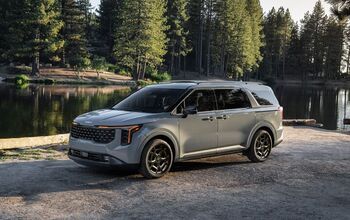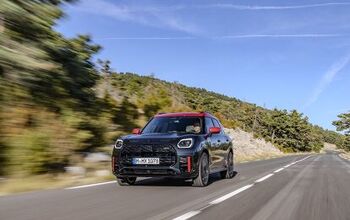2015 Ford Fiesta SFE Vs 2014 Toyota Prius C

The future is frugal. That’s the adage we’ve been hearing for quite some time now. Highly efficient motoring appliances will take over the automotive landscape one day and we’ll all be better for it.
There’s just one problem: cutting edge technology is too expensive for a big chunk of people buying cars. Vehicles like the Tesla Model S, Porsche Panamera E-Hybrid and Cadillac ELR are all state-of-the-art wonders, but they’re expensive.
So what about the rest of us? Well, for decades the way to be frugal on a budget has been to drive a sub-compact car. With small engines and small curb weights, these diminutive vehicles offer efficiency at a low price. And over the past 10-15 years an incredible amount of civility and efficiency has been baked into these little cars.
Small Displacement vs. Hybrid Technology
Ford and Toyota are leading the eco charge with a pair of hatchbacks. Re-introduced to America in 2011, the Ford Fiesta has always been a relatively frugal offering, but for 2015 a new engine has joined the sedan and hatchback lineup. Displacing just one liter, the new three-cylinder turbocharged engine promises to be more efficient than the base 1.6-liter four-cylinder engine without diminishing the Fiesta’s driving experience. With 123 hp and 148 lb-ft. of torque, the new turbo three is actually more powerful than that 1.6-liter unit.
Toyota has taken a different approach to subcompact efficiency, relying on the company’s vast experience with hybrid powertrains. Dubbed the Toyota Prius c, the five-door hatchback uses a 1.5-liter four-cylinder engine paired up to an electric motor. The gasoline engine and electric motor generates a combined 99 hp.
Manual vs. eCVT
Like most other Toyota Hybrids, the Prius c uses an electronic continuously variable transmission (eCVT) to send power to the front wheels. Weighing in at 2,500 lbs., the Prius c’s 99-hp drivetrain has its work cut out. Drive the car the way it’s meant to be driven, slow and efficiently, and the moderate levels of power seem adequate. But drive with any haste or attempt a passing maneuver on the highway and the lack of forward thrust is painfully obvious.
While the Prius c is easy to drive efficiently and keeping up with the flow of city traffic can be a chore, the Fiesta SFE is the complete opposite. With lots of low-end torque, the little Ford has no problem getting up to speed and keeping up with traffic. It takes a conscious effort to eek maximum efficiency out of the Fiesta as too much throttle application builds up boost in the turbo and propels the car down the road.
SEE ALSO: 2014 MINI Cooper Hardtop vs 2014 Ford Fiesta 1.0L EcoBoost
The 1.0-liter turbo behaves a lot like a diesel engine. With gobs of initial torque, as the RPM builds, power tapers off. It’s noticeably quieter when under load compared to the buzzy four-cylinder in the Prius c which is a good thing as the tractor-like noise the Ford engine produces is anything but pleasant.
Uber Efficient vs. Liveable
The Fiesta SFE is only available with a five-speed manual transmission that is similar in operation to other manuals offered in the Fiesta. Throws are long but engagement precise. With total control over gear selection, we found that the way to achieve the most efficient results is to shift according the up and down shift indicators in the Fiesta’s gauge cluster. By driving in this ultra-conservative manner, we were able to achieve a mixed city-highway fuel economy average of 42.8 MPG. That almost ties the SFE’s highway rating of 43 MPG and trumps the city rating of 31 MPG.
That’s quite impressive, until they’re compared to the Prius c. Officially rated at 53 MPG city and 46 MPG highway, we absolutely trounced those figures by averaging 60.3 MPG during the same mixed driving loop as the Fiesta. A lot of that can be attributed to the city driving segments where we found the Prius c can drive on pure battery power for a good distance if careful with throttle input. During our time with the Toyota, we spent 12 to 15 percent of our drive time on just battery power.
Compare Specs
| Vehicle | 2014 Toyota Prius c | Advantage | 2015 Ford Fiesta SFE |
|---|---|---|---|
| Engine | 1.5 L Four-Cylinder + Electric Motor | - | 1.0 L Turbocharged Three-Cylinder |
| Horsepower | 99 HP total | Fiesta | 123 HP |
| Fuel Economy | 53 MPG City / 46 MPG Hwy | Prius c | 31 MPG City / 43 MPG Hwy |
| Observed Fuel Economy | 60.3 MPG | Prius c | 42.8 MPG |
| Weight | 2,500 lbs. | - | 2,537 lbs. |
| Rear Legroom | 35.0-inches | Prius c | 31.2 inches |
| Rear Cargo | 17.1 cu. Ft. | Prius c | 14.9 cu. Ft. |
| Starting Price | $19,905 | Fiesta | $15,190 |
| As Tested Price | $25,335 | Fiesta | $17,705 |
Practical vs. Premium(ish)
We know so because the Prius c is full of technology and mileage screens that let efficiency fans geek out over things like best efficiency runs, gas money saved, miles driven on electricity, etc. Being a fully loaded “Four” model, our test Prius c came equipped with lots of features like faux leather seats and navigation, but a rear back-up camera is strangely missing. None of these features are offered in the Fiesta SFE as it comes in one trim level only.
Materials inside the Fiesta are nicer despite the lower content level as the Prius c is full of cheap, unattractive plastics. The rear window of the Prius is hard to see out of for taller drivers as the rear roof slopes down just above the window cutting off the view. Beltlines in both cars are low allowing for great side sightlines.
SEE ALSO: 2014 Toyota Prius c Review
Up front the Prius trumps the Fiesta with more nooks, bins and shelves to stash stuff. Trunk space also favors the Prius c on paper offering 17.1 cubic feet of space compared to the Fiesta’s 14.9 cubic feet, but in the real world, the deeper Fiesta cargo hold is much more usable. Maybe Toyota is including the space wasted under the trunk’s floor that is taken up by massive chunks of Styrofoam?
Rear seat space is equally optimistic in the Toyota as the Prius c is claimed to 35 inches of legroom compared the Fiesta’s 31.2 inches. But with the front seats set to proper comfort distances, we found it was a wash between the two vehicles as both are cramped but liveable. The actual seat cushions in the Prius did win in comfort slightly though.
A Question of Value
As mentioned, the Fiesta SFE only comes in one trim. This means mandatory wheel covers and no colour display screen. The only two options available for the SFE hatch and sedan are a sunroof and the comfort package. Starting at $15,190 after destination charges for a basic hatchback, the as tested price of $17,705 for our Fiesta SFE 1.0-liter isn’t that hard to swallow.
The Prius c in contrast can be had in four different trim levels. Starting at $19,905 after destination charges, the car escalates up through four trim levels that are simply called, one, two, three and four. Our fully loaded Prius c Four lists at $25,335 including the sunroof and 16-inch alloy wheel additions. That is nearly $8,000 more than the Fiesta which is quite a step up in this market segment.
The Verdict
The Ford Fiesta SFE harkens back to efficient commuters of old, with low content, an efficient engine, a low price and a somewhat engaging driving experience. Being available in one trim and exclusively with a manual transmission, it’s not going to be for everyone. Plus, unless driven ultra-conservatively, mileage numbers at not all that spectacular. It is more fun to drive than the Prius c though and power delivery is livable. Then again, a Fiesta ST starts in the low $20,000 range, is better optioned, a ton of fun and is quite efficient in its own-right.
The Toyota Prius c is a compelling vehicle for those more focused on pure efficiency, but is far too expensive in loaded up “Four” trim. Our pick would be a less optioned Toyota Prius c Two that lists closer to the $20,000 mark and ditches the 16-inch wheels that balloons the Prius’ turning radius from a usable 31.4 foot circumference to a battleship-like 37.4 feet. Cheaper, just as efficient and more maneuverable, that is the Prius c to get.
Toyota Prius c, Ford Fiesta SFE
LOVE IT
- Incredibly efficient
- Various trims available
- Good ergonomics
- Cheapest Prius
- Powerful
- Inexpensive
- Interior
LEAVE IT
- Expensive
- Slow
- Interior quality
- Single trim only
- Not as efficient

A 20+ year industry veteran, Mike rejoins the AutoGuide team as the Managing Editor. He started his career at a young age working at dealerships, car rentals, and used car advertisers. He then found his true passion, automotive writing. After contributing to multiple websites for several years, he spent the next six years working at the head office of an automotive OEM, before returning back to the field he loves. He is a member of the Automobile Journalists Association of Canada (AJAC), and Midwest Automotive Media Association (MAMA). He's the recipient of a feature writing of the year award and multiple video of the year awards.
More by Mike Schlee

































Comments
Join the conversation
let's see; its got a turbo. interesting that you don't mention that means it probably ONLY runs on premium fuel? Which makes its relative inefficiency very much more costly than any car that runs on regular. go to the station. do the numbers. shame for this omission, and my apologies if it runs on regular.
My daughter was recently in the market for an inexpensive, efficient, reliable car that would work in the city where her new job is. We looked long and hard at the Fiesta and Prius C, with passing glances at other cars which all seemed to be less well equipped than the Fiesta. Of concern was a back-up camera, GPS, heated seats, and fuel economy. She bought a Fiesta Titanium with the auto-manual 6 speed and navigation. The 1.6 liter standard 4 cylinder engine avoids the carbon-buildup of direct injection engines. The interior of the Prius C was, IMO, gaudy. I agree that the 3 cylinder DI turbo in the Fiesta came with few options and not much better fuel economy. My daughter, an economics major, also found the fuel savings of the Prius C not better than the higher cost. The Fiesta sedan has a bit more room in it too. The Fiesta feels much more sporty on the road. Glad to have all the choices, but lack of a backup camera on the Prius C models was a big dissapointment as well as its styling and low power. Ford sold us a deeply discounted extended warranty so we shall see about reliability.